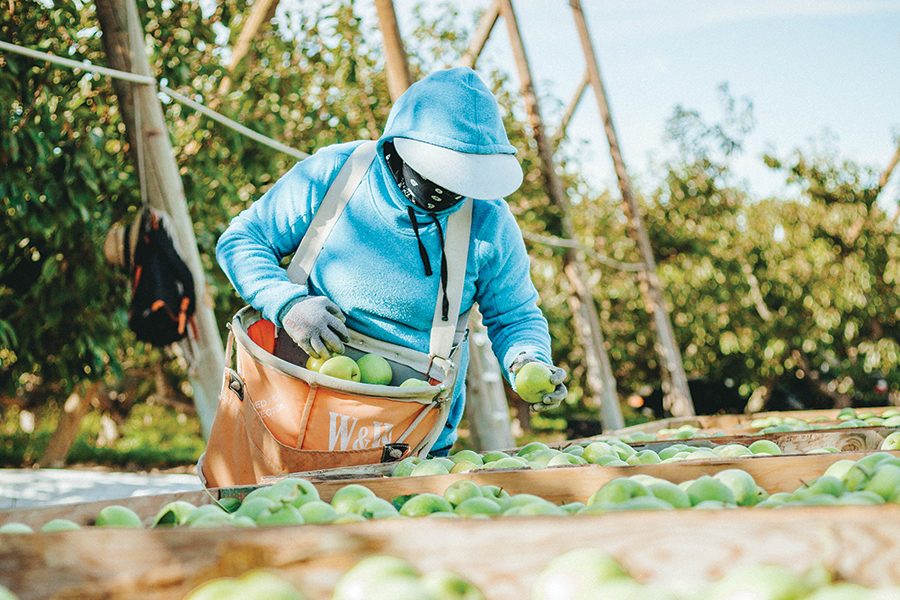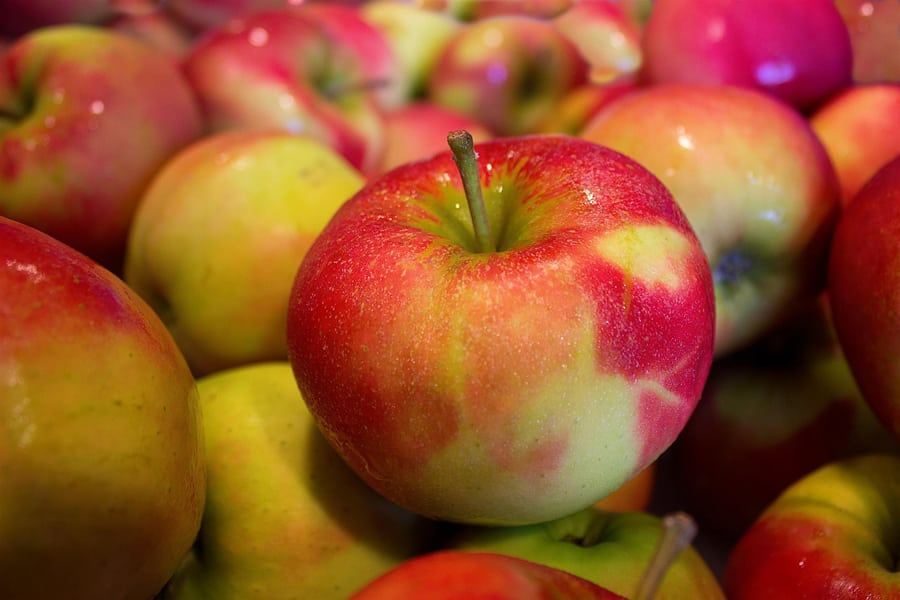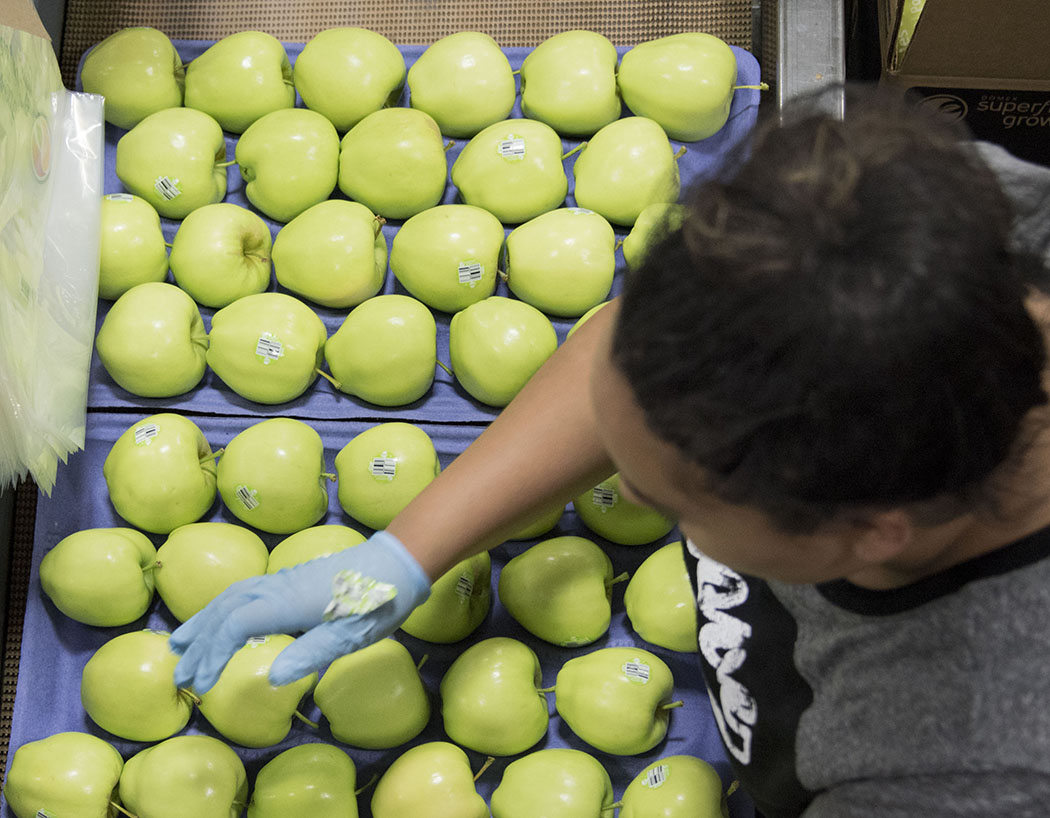
Home » State’s signature crop expected to make a comeback
State’s signature crop expected to make a comeback

June 14, 2023
It could be a more normal year for Washington apples after smaller harvests in 2021 and 2022.
Last year, growers brought in 102.7 million 40-pound box equivalents, according to the Washington State Tree Fruit Association (WSTFA) Statistical Review.
“Before this, 122 million was considered a short crop,” said Todd Fryhover, president of the Washington Apple Commission (WAC).
The low yield was attributed to the 10- to 14-day harvest delay, poor pollination weather and an extreme heat wave that hung over the state in June 2021.
Spring 2023 rolled out more predictably.
“The outlook so far is good,” Fryhover said in mid-April. “We’re between one and two weeks later than normal, but that’s good because occasionally we get those really cold nights, so that looks really good that we’re not at bloom yet. We should have a more normal crop.”
He said the stress of the past couple seasons likely will cause trees to come back healthy and produce a larger crop.
“We could see 130 million (40-pound box equivalents) or more. No one would argue that there’s not at least that much potential there,” he said.
It’s not necessarily bad to have a smaller crop with the inflated cost of production inputs and costs to export both domestically and abroad, he added.
Fewer apples to go around drives a higher per unit price, which can help growers offset elevated costs.
In light of those rising costs, the rate of new trees going in the ground has likewise slowed over pre-pandemic years, with growers opting to experiment with new grafts instead.
This season won’t be without its challenges though.
Market shifts
For the past three years, the apple commission has pivoted marketing efforts to the North American “home court”– Canada, U.S. and Mexico – to combat high shipping costs and an expensive unreliable overseas export market.
Fifty-two percent of all Washington fresh apple exports go to Canada and Mexico, according to WSTFA.
Behind Canada and Mexico, the next top export markets for Washington apples are Vietnam, Taiwan and Indonesia.

China and India used to be bigger markets, but retaliatory tariffs remain in place, making trade expensive. Fryhover said there has been no indication that the Biden administration plans to address that.
In China, the tariff is 55%, while India’s is 70%.
At the same time these countries have been enforcing high tariffs on U.S. imports, they have been developing robust apple industries of their own.
“If you step back and took a picture of the world and looked at Washington, New York, Pennsylvania, Michigan, Canada and Mexico, there are 20 to 30 million bushels grown in Mexico. In the 27 (countries in the European Union), they produce three times as many apples as Washington. In eastern Europe, they produce two times as many, and China produces 48% of the apples grown in the entire world,” Fryhover said.
It’s a logistical jigsaw puzzle assembled atop shifting sand to figure out where all of those apples will go.
“The competitive nature of the international community is getting really intense right now, especially when we have this breakdown of the global trade atmosphere,” Fryhover said, pointing to the Russia-Ukraine war, rising tensions between the U.S. and China and other economic fallout.
In addition, the International Longshore and Warehouse Union has been without a labor contract for several months, affecting some 22,000 West Coast port workers and leading to shipping slowdowns.
“If that labor contract is not in place (at harvest), I don’t know what’s going to happen,” Fryhover said in mid-April.
Those factors considered, “taking care of our home court becomes even more important as we move ahead into this next crop year,” he added.
This year, the percentage of the harvest that will be exported is expected to be around 20%. Fryhover said it’s normally between 28% and 32%, but the crop estimate and need in the domestic market reduces the export share.
The big question remains: what to plant?
With new varieties coming out all the time selected for modern tastes, and the lag time between sapling and first harvest, it’s challenging for growers to decide.
Newer varieties tend to cost more per acre, so it can be a costly gamble to convert ground to what’s trending versus old standbys.

Though Washington’s state fruit, the Red Delicious, continues to be the “flagship export variety,” unique and sought after internationally, Cosmic Crisp, Honeycrisp and other proprietary varieties like Smitten, Lady Opal and Ambrosia are attracting consumers’ attention at home.
“The Washington Apple Commission is focused on promoting Cosmic Crisp in export markets. Right now, our main focus is in Canada but we also are supporting volumes into other countries such as Taiwan and Vietnam. We recognize that with increasing production, Cosmic Crisp will need export markets in the coming seasons,” said Rebecca Lyons, international marketing director at WAC.
Labor crisis
Labor continues to be a challenge for apple growers and also is exacerbated by the downward economic trends.
About 30,000 foreign workers were sourced through the federal H-2A program last year to pick the apple crop alone. A low unemployment rate means even less interest than usual from domestic workers.
Visa processing has likewise been slowed down due to international turbulence.
The new challenge facing farmers that phased in last year are new rules affecting overtime. In 2022, those working over 55 hours a week were required to be paid time and a half. This year, it drops to 48 hours and applies to H-2A workers as well as domestic workers.
“We’re ratcheting down to 40 hours,” Fryhover said, explaining that it’s a tough rule to apply to an industry that naturally has big ebbs and flows.
“In the tree fruit industry, we do everything at once … Once we get the apples harvested, we can get some normalcy of hours for workers, but we have to get apples off the trees as fast as we can,” he said.
He said growers will have to make some tough calls this season about what to harvest as they ride that narrow line of profitability.
All in all, Fryhover said in 2023 “we can only do better, no matter how you look at it … We’ll just have to see what happens.”
Agriculture + Viticulture
KEYWORDS june 2023




